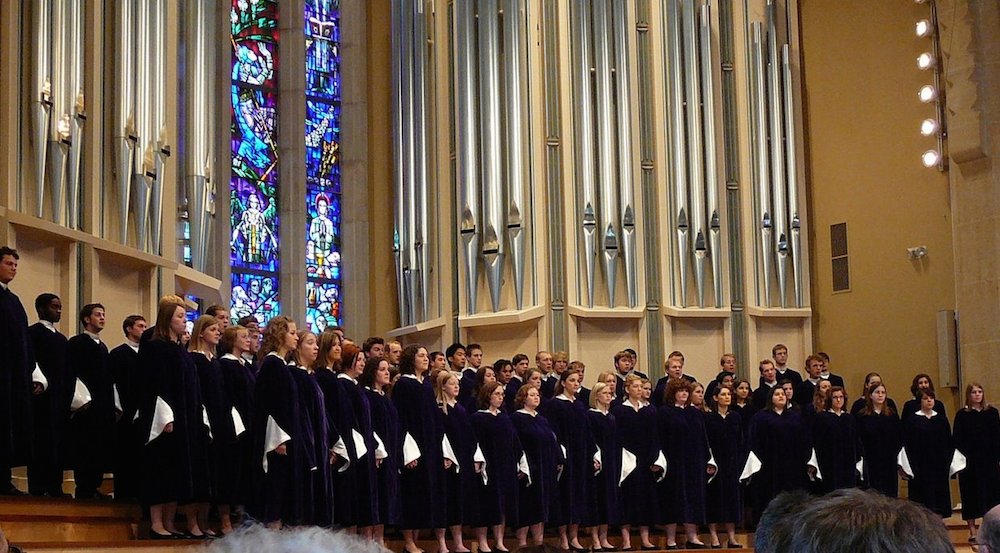Excitement filled the air as attendees of the St. Olaf Choir Concert struggled to find a seat. Having the reputation of being the “premier a cappella choir in the United States,” it came as little surprise why the attending community members were so excited.
Met with applause, the 75 purple-robed members of the St. Olaf Choir filed onto the stage. The choir is composed of a diverse group of undergraduate students, and although music education and performance are popular majors among the members, many have very different interests such as computer science, biology and philosophy. However, their love of music and collective talent are what grab the attention of audiences around the country and the globe.
They were followed by their conductor of 25 years, Anton Armstrong. Armstrong is the fourth conductor to hold the position since the group’s formation in 1912 by F. Melius Christiansen. Each new conductor builds on the changes and advancements made by his predecessors and though Armstrong still sees himself as the “new conductor,” he has expanded the choir’s repertoire to include music from the Pacific, Africa, Latin America, Australia, New Zealand and the United Kingdom.
The organ that dominates the back wall of the Emerson Concert Hall stood silent as the voices that comprise the St. Olaf Choir filled the air. The group began with a performance of “The Lord’s Prayer.” Though this song was exactly what the title suggests, this performance was far from a church service. This was about the music.
Since its creation and rise to fame as one of the most recognized choirs in the country, the St. Olaf Choir has performed around both the country and the world. With numerous television specials and even more CDs, many in the audience came to the performance with a relative idea of what it would be like. This, however, did not in any way lessen the awe of the crowd once the performance began.
Accompanied by Charles Gray, a St. Olaf College professor of music, on either viola or violin, St. Olaf certainly showcases the array of talents of the young performers. Their performance is geared towards showing exactly what the human voice can do. As the performers sway to the music, a tradition started by Armstrong, it is impossible to single out an individual voice in the perfect blend of harmonized sound. With songs performed in English, German, Hebrew and Latin, and time periods ranging from the late 16th century to modern day, Armstrong and the St. Olaf Choir allow for actual words to be less important than the sound and the meaning of the performance.
Of every song performed, the piece that most exemplified this was the performance of “Past Life Melodies” composed by Sarah Hopkins. It is based on Australian Aboriginal music and culture that fascinated Hopkins while she was living in Darwin, Australia. In this particular piece, two performers stood in front of the rest of the group and whistled in a way that gave the illusion of a flute being played. Meanwhile, the rest of the choir mimicked the sound of a didgeridoo being played on a stage void of physical instruments. In his introduction to the piece, Armstrong explained that harmonic overtones, an ancient musical device, allow for this haunting performance of powerful and melancholy notes. Armstrong also welcomed a special guest to the concert: Anthony Bernarducci, the composer of “Veni Creator Spiritus,” who was present for the performance of his piece.
Though officially accompanied by viola, violin or piano, the audience’s own chorus of astonishment added to the music. Though admittedly less polished than the music from the performers, hushed “wows” from the community members, myself included, created a connection between everyone present, performer or viewer alike.
Throughout the performance, the members of the St. Olaf Choir held hands. The performers were linked by their love for music and their talent while the audience could do little to hide their wonderment.
At the conclusion of the performance, Armstrong spoke on the talent and dedication in the choir. He addressed the importance of music and teamwork, not only within his choir but also in the world. He theorized the positive outcome of forming a choir of world leaders. Because of the required teamwork, these leaders would have to work together to make something beautiful. This received a collective chuckle from the audience.
With every direction, Armstrong and his choir were able to show the capacity of the human voice. From the first note, (and every note after that) the talent of the performers drew in the audience from around campus and also the community. This performance showed the power of music both in the sheer talent of the performers and also in the message of hope that hung on every note.
– By Maggie Pavleszek, Contributing Writer
The Emory Wheel was founded in 1919 and is currently the only independent, student-run newspaper of Emory University. The Wheel publishes weekly on Wednesdays during the academic year, except during University holidays and scheduled publication intermissions.
The Wheel is financially and editorially independent from the University. All of its content is generated by the Wheel’s more than 100 student staff members and contributing writers, and its printing costs are covered by profits from self-generated advertising sales.







